Curious about best practices and species to look for when mushroom hunting in Georgia? Familiarizing yourself with how to safely forage popular, edible mushrooms in Georgia will help keep you safe and increase your chances of a successful foray.
In this guide, we’ll discuss best practices for wild mushroom hunting, which popular species to look for in Georgia and describe some of the best places in the state to forage.
Read on to learn more.
Guidelines for Mushroom Hunting
Regardless of what state you’re foraging in, or what species you’re looking for, it’s important to follow guidelines for ecologically-centered, cautious, and smart foraging.
Some folks may find the idea of hunting for wild mushrooms to be terrifying. What if you pick and eat a deadly poisonous species? Accidental self-poisoning of toxic wild mushrooms certainly does occur, although serious or deadly poisonings are quite rare in the U.S. A healthy dose of caution and respect for the beautiful world of fungi is important, but you don’t need to be paralyzed with fear. You don’t even need to consume mushrooms to be an avid mushroom forager. There is plenty to learn and experience by simply going out in the woods and taking photos and samples of interesting fungi. Whatever your goal is, the best plan is to be committed to learning and seeking the advice of mushroom experts.

Picking mushrooms can be a fun and safe hobby, but you need to follow certain guidelines.
©iStock.com/PIKSEL
Guidelines
The following guidelines will help you get started on the right track:
- If you are new to mushroom hunting, it’s best to accompany a mushroom expert on a foray. An excellent way to achieve this is through joining a local or regional mycology club.
- Never consume a wild mushroom if you aren’t 100% sure of its identity as a safe, edible species. Labs can confirm a sample if you don’t have access to a mycologist or mushroom expert to help confirm your find. Well-respected forums, up-to-date field guides, and dichotomous keys can aid you in identification.
- If you intend to collect specimens, bring a woven basket or mesh bag. These containers will allow increased ventilation and ensure mushroom spores can travel across the land as you walk.
- Wear clothing appropriate for a hike in the woods or meadow. If it is hunting season, you may want to wear bright orange.
- Bring water, snacks, and a first aid kit if you’re planning a multi-hour outing.
- Practice mindful hiking and avoid trampling areas or unnecessarily creating new trails.
- Only pick what you can reasonably study or consume. Remember that other species in the environment feed on wild mushrooms.
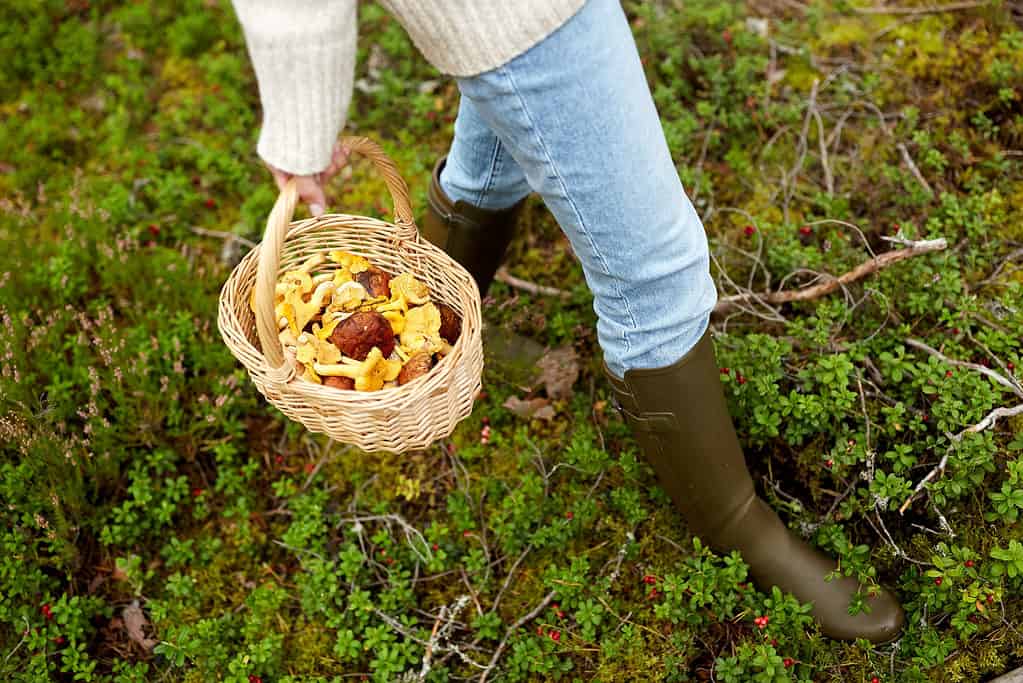
A wicker basket can help you spread spores, that is assuming you want this species to spread.
©iStock.com/dolgachov
Mushroom Hunting in Georgia: Popular Species to Forage
To increase the chances of a successful and enjoyable foraging expedition, it’s important to know how to identify a couple of the most popular, edible wild mushrooms in your area. Additionally, if you’ll be looking for edible species, you’ll also want to be aware of poisonous lookalikes that may fruit in the same time and area.
Below, we’ll highlight three of the most popular types of mushrooms to forage in Georgia and mention if any poisonous lookalikes occur. In addition to the featured three mushrooms below, other commonly foraged mushrooms in Georgia include:
- Morels (Morchella spp.)
- Pheasant back mushroom (Cerioporus squamosus)
- Chicken of the Woods (Laetiporus sulphureus)
- Dark honey mushroom (Armillaria mellea)
- Artist’s conk (Ganoderma applanatum)
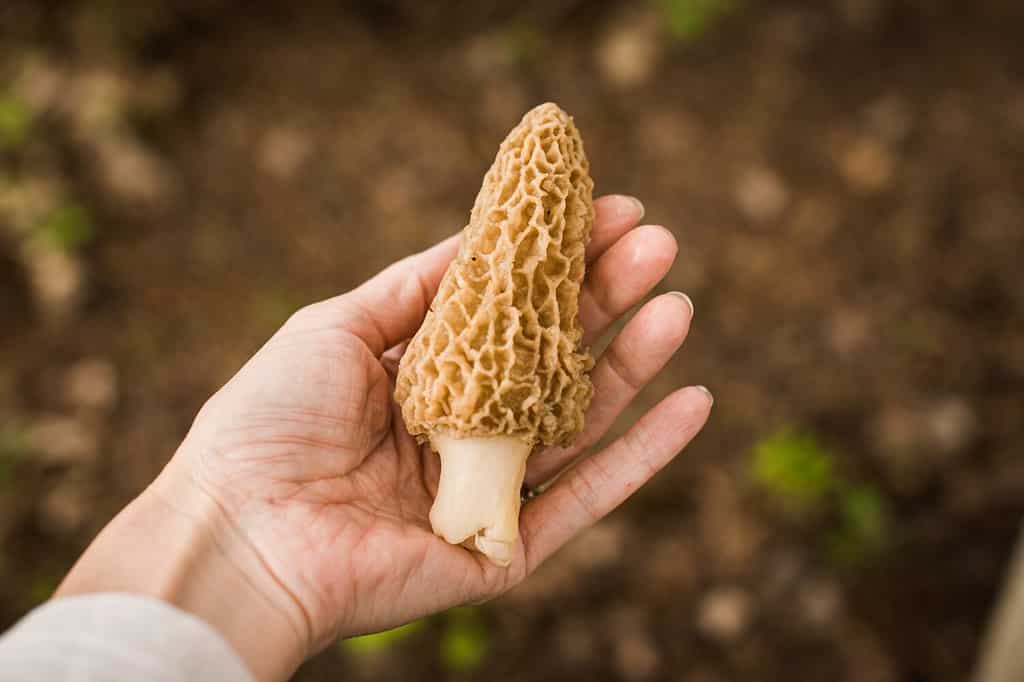
Morels can be quite distinct looking, once you learn the look-alikes.
©Krista Parker/Shutterstock.com
Turkey Tail Mushroom (Trametes versicolor)
While many foragers seek out the most scrumptious of wild mushrooms, some are on the hunt for mushrooms with purported medicinal benefits. One of the most common mushroom species to occur in North America is the turkey tail mushroom (Trametes versicolor). It also happens to be highly regarded in the natural medicine world for a variety of medicinal uses.
Across the world, scientists are studying turkey tails for several pharmaceutical properties. In Japan and China, doctors have used Trametes versicolor for decades as a complementary therapy against several types of cancers.
In Georgia, turkey tail mushrooms are widespread across the state. These mushrooms are saprobic, deriving their nutrients from decaying organic matter. In the case of Trametes versicolor, this mushroom prefers to grow on the deadwood of hardwood trees. Rarely, they may occur on conifers. Not only do they abundantly fruit across the hardwood and mixed forests of Georgia, but they also occur year-round.
Identifying Features of Turkey Tail Mushrooms
Look for bracket mushrooms growing in dense, overlapping clusters or in rosette patterns on logs and stumps. The cap is fan to semicircle-shaped, often fused to other caps, and flexible when the specimen is fresh. It should be velvety to the touch and feature concentric bands of various colors. These colors are commonly brown, cinnamon, orange-brown, reddish brown, and blue-gray. The margin is white. Underneath, the white pore surface features tiny but visible pores. Older specimens may have an off-white to pale tan pore surface. The spore print is white. Caps are typically .75-3 inches across.
Poisonous Lookalikes
There are no known poisonous lookalikes for turkey tail mushrooms. There are, however, several non-toxic look-alikes, such as the aptly named false turkey tail (Stereum spp.)

can come in many different colors, hence the name.
©bogdan ionescu/Shutterstock.com
Hen of the Woods (Grifola frondosa)
Appearing in late summer and continuing through fall, hens of the woods (Grifola frondosa) is a lovely, edible polypore mushroom. Also known as maitake, this polypore is a choice of edible and often appears in large, dense rosette clusters at the base of oak trees. This mushroom is both saprobic and weakly parasitic, so you may find it on logs, stumps, and at the base of living and dead hardwoods. In Georgia, this mushroom most commonly occurs in the central and northern portions of the state.
Hen of the woods clusters can grow quite large, reaching up to 36 inches across. Individual caps typically measure 1-6 inches in diameter. Each cap is roughly fan-shaped with wavy margins and features pale to dark brown-gray coloration. Sometimes, pale yellow, gray, or brown banding occurs on the outer portion of the cap. The angular, almost tooth-like pores run down the rudimentary stem (stipe) of the mushroom. When young, the pores are lavender-gray, fade to white, and finally stain yellowish with age. The flesh is white, firm, and does not change color when bruised or sliced. The spore print is white.
Poisonous Lookalikes
There are no known poisonous look-alikes of this mushroom. You may, however, mistake hen of the woods for other edible polypores, such as the black-staining polypore (Meripilus sumstinei), Berkley’s polypore (Bondarzewia berkeleyi), or even an aged chicken of the woods (Laetiporus sulphureus).
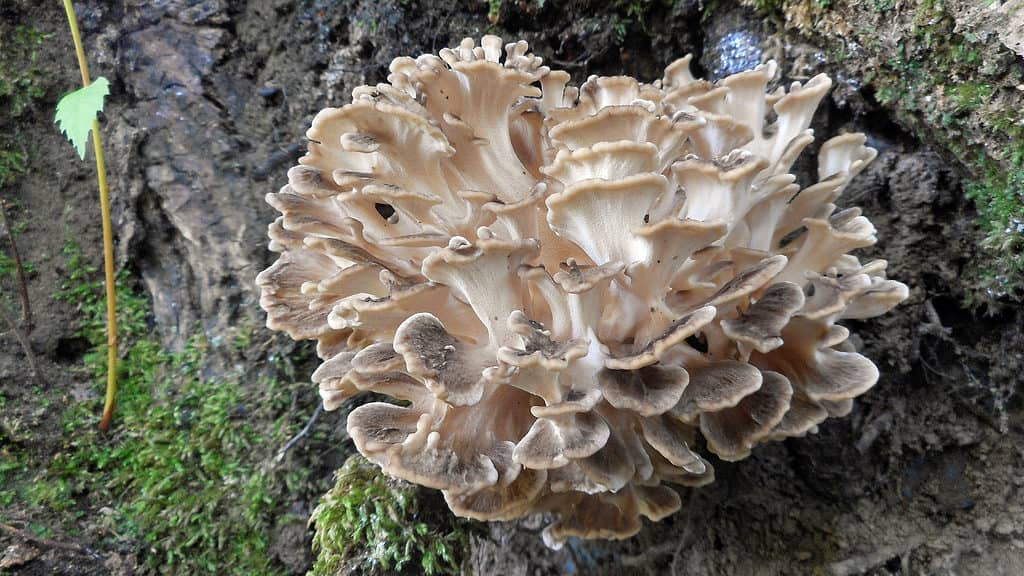
Known mostly to grow on oak, this mushroom can sometimes be found on other hardwoods.
©Lorenzo Martinelli/Shutterstock.com
Common Puffball (Lycoperdon perlatum)
A delightful, whimsical mushroom, the common puffball (Lycoperdon perlatum) occurs across a range of habitats in Georgia. You can find this edible mushroom in woodlands, yards, and meadows. In temperate zones, it fruits from late spring through fall. In southern Georgia, you may find this mushroom fruiting in winter as well. These mushrooms are saprobic, most often growing on heavily decayed wood or mulch. When young and fresh, these mushrooms are commonly edible, but they do not have much flavor.
Identifying Features of the Common Puffball
When young, Lycoperdon perlatum is bright white and covered in tiny, almost glittery “pearls”. The fruiting body is often shaped like an inverted pear with a softly rounded top. These delightful mushrooms measure 1-3 inches high and can fruit alone, scattered, or in clusters across the forest floor. Pulling the spines off leaves pockmarks on the delicate outer layer. When young, the flesh inside is bright white and spongy.
As the common puffball ages, the exterior changes from tan to brown and the exterior easily collapses with slight pressure. The top of the mushroom develops a perforation through which spores can escape in puffs. Raindrops, wind currents, trampling, etc., can cause mature puffballs to release their clouds of spores. Inside an aged Lycoperdon perlatum, the flesh turns to an olive-brown spore powder.
Poisonous Lookalikes
If you are going to forage for young common puffballs, it’s crucial to ensure you are picking Lycoperdon perlatum, and not its deadly lookalike– the egg-like stage of a few deadly poisonous Amanita species. In Georgia, you are most likely to find the eastern North American destroying angel (Amanita bisporigera) co-occurring in woodlands with the common puffball. To confirm you are looking at a young common puffball, cut the mushroom vertically down the center. The inside should be filled with a solid, white, spongy flesh. In contrast, an immature Amanita bisporigera will contain a developing stipe, gills, and cap inside the egg-like casing.
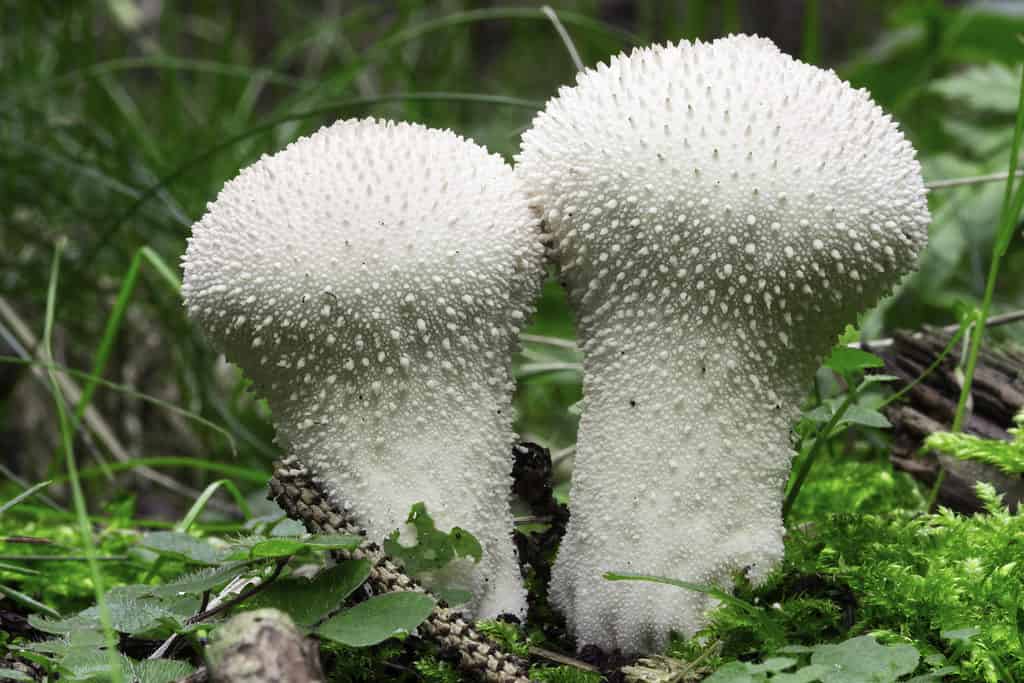
Make sure to confirm the identity of the common puffball since it can look like the immature phase of some incredibly toxic amanitas.
©gstalker/Shutterstock.com
Mushroom Hunting in Georgia: Best Places to Forage
Georgia is home to some awesome locations for mushroom hunting. Remember, not all parks allow the collection of mushrooms. It’s best to familiarize yourself with the regulations of areas you’re interested in. Some places in Georgia, such as state parks, don’t allow any foraging due to wildlife protection. Other areas, such as national forests, often allow a limited amount of forage per day or season with a permit.
Below, we’ll talk about three locations in Georgia that are great spots for mushroom hunting and allow foraging.
Mushroom Hunting in Georgia: Chattahoochee-Oconee National Forest
Covering nearly 867,000 acres, the Chattahoochee-Oconee National Forest is home to a stunning wilderness in Northwest Georgia. The forest ecology of the Blue Ridge Mountains and the Piedmont Mountains, and over 2,200 miles of rivers and streams make this region an excellent location for mushroom hunting.
If you wish to mushroom hunt in the Chattahoochee-Oconee, you’ll need to obtain a permit. If you are interested in only hunting for under a gallon of mushrooms on your foraging trip, the permit may be free. Your best bet is to contact the closest ranger district and inquire about the specifics.
Joe Kurz Wildlife Management Area
Located between Atlanta and Columbus, Georiga, the Joe Kurz Wildlife Management Area offers 3,700 acres of oak-pine-hickory forests, meadows, and a small lake. You are typically not required to obtain a permit for limited, personal-use foraging for mushrooms on Georgia WMA lands. However, you may need to obtain a day-use permit to access the management area, depending on the location.
Mushroom Hunting in Georgia: Allatoona Wildlife Management Area
If you live in Atlanta, you can head one hour north to the beautiful Allatoona Wildlife Management Area for near-city mushroom foraging. This 6,818-acre property features mixed woodlands and the Allatoona Lake. Camping is available nearby for extended forays. Since this area is part of the Georgia WMA lands, you can forage personal-use mushrooms without a permit.
Mycological Clubs in Georgia
If you’re interested in joining a mycological club in Georgia to attend forays, learn about mushroom I.D., and connect with other mycophiles, you can check out the Mushroom Club of Georgia. An affiliate of the North American Mycological Association, this club hosts a variety of online and in-person educational activities throughout the year, led by mushroom experts and qualified mycologists.
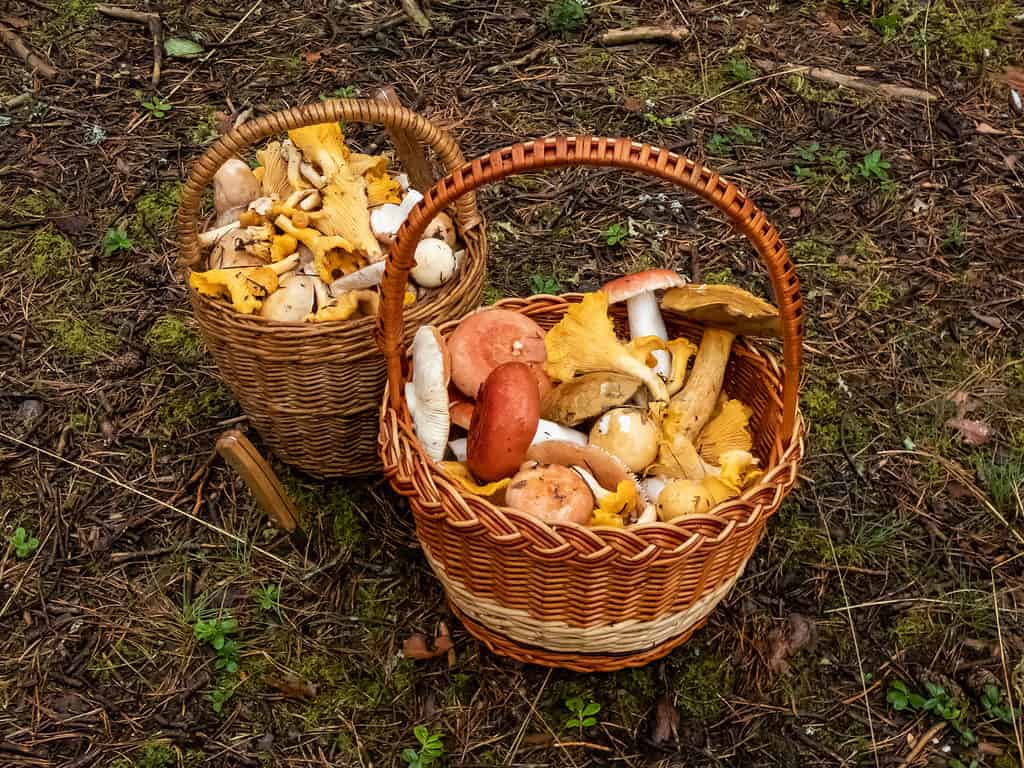
Once you hone your foraging and ID skills, at the right time of year, you can easily fill a basket or two of delicious, edible mushrooms.
©Kristine Rad/Shutterstock.com
The photo featured at the top of this post is © SimonaZorina/Shutterstock.com
The information presented on or through the Website is made available solely for general informational purposes. We do not warrant the accuracy, completeness, or usefulness of this information. Any reliance you place on such information is strictly at your own risk. We disclaim all liability and responsibility arising from any reliance placed on such materials by you or any other visitor to the Website, or by anyone who may be informed of any of its contents. None of the statements or claims on the Website should be taken as medical advice, health advice, or as confirmation that a plant, fungus, or other item is safe for consumption or will provide any health benefits. Anyone considering the health benefits of particular plant, fungus, or other item should first consult with a doctor or other medical professional. The statements made within this Website have not been evaluated by the Food and Drug Administration. These statements are not intended to diagnose, treat, cure or prevent any disease.
Thank you for reading! Have some feedback for us? Contact the AZ Animals editorial team.







